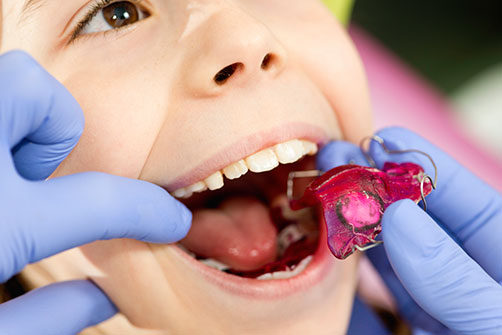Children's Braces in Langley: Early Intervention Orthodontics
If you're the parent of a child who might need orthodontic treatment, we're here to put your concerns to rest! Early Orthodontic evaluation and treatment for children is integral in ensuring that they get off to a great start with their lifelong oral health.
Why is Early Orthodontic Intervention so Important?
We know that by the age of 4 years old, roughly 60% of facial development takes place. By the age of 12 years old, this number increases to 90%.
This means that the early years (ages 5-11) are critical. In fact, the Canadian Association of Orthodontists recommends that every child visit an orthodontist before age 7 for an initial assessment.
If we can catch developmental issues early on, we may be able to address the root cause of the problem and guide proper jaw development.
Braces for Kids
There are several signs that indicate that a child may need orthodontic treatment, including trouble chewing and breathing, crowded teeth, clenching or teeth grinding, speech problems, jaw clicking, and more.
The orthodontist will consider your child's overall health and mouth structure to determine the right type of braces (such as traditional and coloured braces, In-Ovation® braces, and more), the treatment duration, and any additional procedures needed.
This can include recommending additional devices like orthodontic expanders to be used in conjunction with your child's braces. These devices are designed to help address the issues at hand to achieve optimal oral outcomes.
Orthodontic Benefits for Children
While the recommended age for an early orthodontic evaluation is 7 years old and Phase I treatment occurs between 6 and 10, children often get braces anytime between the ages of 10 and 14. However, this can vary based on specific needs.
When treatment begins while a child is still young, the orthodontist can better guide the growth of the jaw and the development of the emerging permanent teeth.
Treatment tends to be efficient and more manageable for children because their jawbone is less dense during its development. This allows them to achieve a straight and healthy smile, as well as a proper bite, as they transition into their teenage years. This can help set them up for a lifetime of good oral health.
Understanding Braces for Children: What Parents Need to Know
-
Can a child with baby teeth undergo orthodontic correction?
Yes. Some orthodontic problems are significant enough early on to warrant immediate intervention.
On the other hand, if your child is not yet ready for treatment, we will carefully monitor his or her growth and development in the mean time, until he or she is ready for treatment.
-
How old should my child be to visit the orthodontist for the first time?
There are many orthodontic problems that are significantly easier to treat if they are detected at an early age.
The Canadian Association of Orthodontists recommends that children should first visit an Orthodontist no later than the age 7.
Some children will not require a treatment plan until they are between the ages of 11 to 13. However, because the first permanent incisors and molars have usually erupted by age 7, orthodontic conditions like crowding, cross bites, and a a variety of others can be evaluated at this time.
-
What does Phase I Treatment involve?
Phase I (otherwise known as early interceptive) treatment is a limited form of orthodontic treatment (e.g., expander or partial braces) that takes place before all of the permanent teeth have erupted. Phase I treatment takes place most often in children between the ages of 6 and 10. It's usually recommended in cases where more space is needed in the mouth for developing straight teeth, and fo...
-
What orthodontic problems can occur before the age of 7?
There are a many reasons a child might need orthodontic intervention at an early age. Early phase treatment may reduce or prevent the need for more invasive, time consuming treatment later on.
When treatment is initiated when a child is still young, the orthodontist can better guide the growth of the jaw and the development of the emerging permanent teeth.
The following issues can be treated with orthodontic services:
- Thumb-sucking
- Trouble with chewing and breathing
- Late or early loss of baby teeth
- Teeth that are crowded, loose, or impacted
- Upper and lower teeth that do not meet correctly
- Improper jaw alignment
- Tongue thrusting
- Crossbites
-
Will my child still need full braces if he/she has Phase I Treatment?
Phase I Treatment is done in anticipation for Phase II treatment, not instead of it, so your child will more than likely need full braces for kids later on.
Early orthodontic treatment can also help regulate the width of the upper and lower dental arches, gain space for permanent adult teeth, prevent the need to extract permanent teeth, reduce the occurrence of impacted permanent teeth, break thumb-sucking habits, and eliminate tongue thrusting or speech problems.
Phase I treatment, in other words, is designed to help make Phase II treatment more efficient and more effective.

